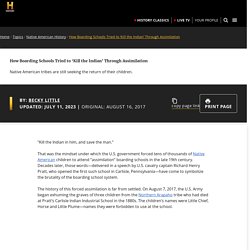

How Boarding Schools Tried to ‘Kill the Indian’ Through Assimilation. “Kill the Indian in him, and save the man.”

That was the mindset under which the U.S. government forced tens of thousands of Native American children to attend “assimilation” boarding schools in the late 19th century. Decades later, those words—delivered in a speech by U.S. cavalry captain Richard Henry Pratt, who opened the first such school in Carlisle, Pennsylvania—have come to symbolize the brutality of the boarding school system. The history of this forced assimilation is far from settled. On August 7, 2017, the U.S. Army began exhuming the graves of three children from the Northern Arapaho tribe who had died at Pratt’s Carlisle Indian Industrial School in the 1880s. Students at Carlisle and the roughly 150 other such schools that the government opened were susceptible to deadly infections like tuberculosis and the flu. Carlisle and other boarding schools were part of a long history of U.S. attempts to either kill, remove, or assimilate Native Americans. Native American Cultures - Facts, Regions & Tribes.
Many thousands of years before Christopher Columbus’ ships landed in the Bahamas, a different group of people discovered America: the nomadic ancestors of modern Native Americans who hiked over a “land bridge” from Asia to what is now Alaska more than 12,000 years ago.

In fact, by the time European adventurers arrived in the 15th century A.D., scholars estimate that more than 50 million people were already living in the Americas. Of these, some 10 million lived in the area that would become the United States. As time passed, these migrants and their descendants pushed south and east, adapting as they went. In order to keep track of these diverse groups, anthropologists and geographers have divided them into “culture areas,” or rough groupings of contiguous peoples who shared similar habitats and characteristics. The Arctic The Inuit and Aleut had a great deal in common. Cheyenne River Youth Project – Over 25 Years of Serving Lakota Youth. Lakota in America. Inside an Apache Rite of Passage Into Womanhood. Youtube. The Center for Mind-Body Medicine: Pine Ridge Indian Reservation.
Five Native Films You Should be Streaming in 2018. It’s impossible to quantify the impact of Native films.

The documentaries correct false perceptions and the fictional stories are universally cathartic. They remind their viewers that Indigenous people have always been vital to America’s identity and evolution. The films in this column assert this truth through music, sport, and even healing from trauma. They also share stories that affirm the bonds of family and the necessity of caring for fellow human beings. For the third year running, I’m thrilled to recommend some of the wonderful works Indigenous people have written, directed, produced, and starred in. Rumble: The Indian Who Rocked the World This documentary celebrates Native Americans’ contributions to popular music. Native films are becoming increasingly important and streaming them is allowing America’s first citizens to share their stories with more people than at any other time in history.
A day in the life of a 17yr old on the Navajo Reservation. Lakota Waldorf School on Pine Ridge Indian Reservation. Havasu Falls and Havasu Creek (5D Mark II) Pine Ridge Indian Reservation Lakota Nation, South Dakota - Team Effort Mission Trip. Access VG1: Native Americans / The Pechanga Teach ...